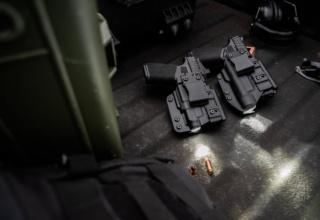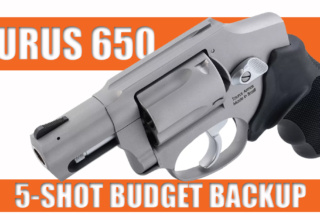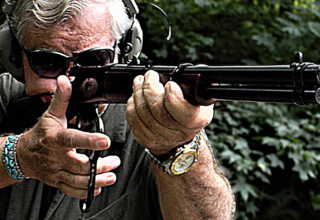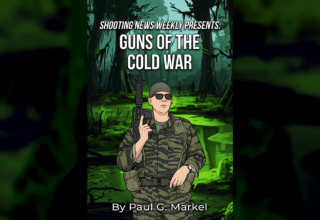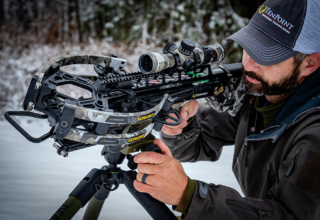Tips to consider and thoughts to ponder for older firearm students
by Bob Campbell
Age detracts from physical strength and stamina. As you reach over sixty years of age, it is difficult to improve your fitness, but you may maintain what you have with a little effort. I believe it is an embarrassment to be as out of shape as so many Americans are today.
I have reached a certain comfortable age closer to seventy than sixty. In all modesty, mental drills and comprehension seem better than ever. Physical skills…not so much. Barring replacing my knee joints with constant velocity drive shaft joints from a ’71 Chevy, they will never articulate properly again. It takes longer to heal from strains and scrapes. I just do it anyway. I take it a little easier at times, but my daily wear isn’t slip-on shoes and sweatpants. I try to dress for the occasion and hope that occasion is hiking or traveling to more than just funerals. I have not given in to too much to comfort when it comes to carry guns. Glocks, 1911s, and Pythons are daily companions. Most are general purpose defensive firearms. The revolvers are more specialized and are intended for animal defense. A 1911 never feels wrong and a revolver feels right in the forest and mountains. I occasionally carry a SIG P365 or Hellcat 9mm when discretion is needed. So, I give a little.

When some older shooters face aches and pains, they seek comfort. Others press on. I won’t mention him by name, but I have the greatest respect for a Colonel in the US Army who suffers pain from arthritis and joint disease. He works out every single day and he functions. In my experience and life observation, the more comfortable we are the more quickly we age — and waste away. Wood grown on a tree farm is fairly plain. Trees from a forest that suffered storms and times of less-than-ideal nutrients produce beautiful patterns. Storms often bring lush vegetation. A vigorous lifestyle results in greater resistance to aging’s effects. Hard work is beneficial — alcohol and tobacco are not, not to mention drugs.
I have somewhat listened to doctors and the surgeon general most of my life. I know folks who don’t listen. I write for the ones who do. Alas, the good life is no guarantee. I recently lost a wonderful cousin only a year older than me who did everything right and enjoyed retirement very much. The odds are with us, though, if we combine exercise and nutrition. Not to mention personal defense skills.

In working up this report, I addressed issues I have dealt with. Exertion must be part of your physical vocabulary. Complacency is as sure a killer as if you had planned your own demise. Training and lifestyle must deal with pragmatic truths. The tactics I use and those I teach are the result of an appraisal of their validity and my ability and fitness to fight. I am not SWAT-capable (that is for certain) but then, was I ever? I can’t scale a mountain incline as I once did but eventually I get there. It’s just putting one foot after the other. My assessment is graded on the curve, with age a factor. I am not self-impressed easily and continue training with objectives. In firearms training, I don’t enjoy Magnums and shotguns as much as I once did. I use the Renegauge gas-operated shotgun with its gel-filled buttstock as I have arthritis in the shoulder — a new thing that irks. I get through it. My front-line house gun is a PCC with a red dot sight (to my own surprise).
I should be good at movement and taking cover, as I have practiced for many years. This is as important as firing accurately since avoiding getting shot is a huge part of the battle.

Some things have changed, and some have not. I practice the open hand, the knife, and the stick — the stick more often these days as I need a walking cane from time to time. Not every day, but when I need a cane, I really, really need a cane. Never underestimate the worth of a heavy stick or cane. (Not a ridiculous flea market sword cane! I would much rather have a blunt striker.) Considering the time I can spend walking trails from the Natchez Trace to Appalachian ghost towns and the need for a good stick cane, it only makes sense to master the art. Snakes are easily dispatched with a stout cane. When old injuries come to visit, I find the cane is useful. Don’t be embarrassed and don’t put off obtaining a good walking stick or cane. Let’s look at some low-impact drills suitable for older folks like me or anyone with a disability. I don’t intend to injure myself more in training than I already am! Things beyond our control weaken bones and take away muscle. Let’s be realistic and do the dead-level best we can with what we have.

About twelve years ago, the Pretty Girl and I were on our way to Paris. I was in my early fifties, and I suffered an inguinal hernia while working out. I still worked a public job in a secure facility, and in between magnetic labs and other radiation research areas, I checked certain parts of the facility. I enjoyed running for part of my rounds and lifting up and swinging over ladders and rails. Had a good time of it. Two weeks before the flight, I ripped something. My doctor told me it wasn’t that bad and that I was lucky. (I waited five years to repair it.) I said, “I am going to France, and this is going to kill me.” He laughed and said there is more chance your plane will crash than the hernia will rupture, which was reassuring. A cousin a tad older than me fell off his roof and ripped a rotator cuff while trying to save money by cleaning his own gutters. Sometimes exertion is good but do it the right way! When you are older and jump into a regimen, you could have a coronary, so be certain you are capable. You may have a rip or tiny tear in a muscle and not realize it. Pushing too hard finishes the job. Don’t overdo it…but do it!
Shooting Drills
Even after retirement or semi-retirement, you must address shooting drills. With time on your hands, there is worse you could do! I still work not because anyone in the family asks or demands it of me, but because I love my family and some of what I do for them costs money.

I don’t aimlessly shoot drills that I enjoy. I stretch the envelope. I run multiple target drills because thieving scum tend to run in packs. I still use revolvers. It is amazing how quickly and accurately you may fire a revolver with good training and practice. (If I carry a revolver in town, I carry two.) I spend time working up drills that relate to reality, yet I don’t neglect fun shooting. Some of these handguns are a joy to fire and use. My knees don’t hurt but are crap for what I used to do. When firing from kneeling, I am careful getting into position and I know that I cannot rise quickly. I don’t use my knees as much as I roll my hips to one side and then up. It works well, as does a knuckle boost, which makes me look like an ape, but that’s ok, too.
As it turns out, as I learned in discourse with trainers and instructors, a lot of folk are not really interested in learning new things. They are not terribly enthusiastic concerning putting forth effort. Middle-aged shooters manage to operate a computer, a TV remote with endless channels, a phone, or play video games with the grandchildren. Shifting emphasis in training and addressing new drills and equipment isn’t that difficult. Work out your weak points and blind spots. Try something you are not particularly good at when you first begin. You are probably good at many things. The new drills will come under control. Rest, hydrate, take a pen, and follow the pen in the air, making the infinity symbol as you rest your eyes and avoid eyestrain. But don’t stop. Wear good shoes and proper headwear. Don’t take a chance of falling and don’t stress the rotator cuff.

A great shooter I know well was suffering from shoulder pain. He had the surgery and no more pain. It seems that often enough the cure isn’t what we hoped; his was…to a point. He belted on his trusty 1911 Commander in an inside-the-waistband holster and could not reach it after surgery. No pain, just a little lost motion.
I had a rather bad on-the-job injury from a fight (you should see the other guy when he got out of prison) and suffered a similar loss of motion in the non-dominant arm I hardly notice. So, we dug out the holster box and my friend went AIWB with excellent results. He even wondered why he didn’t go appendix to begin with! As for my own shoulder problems, I am carrying a Springfield Commander or TRP CC as my draw is not as sharp as it once was. The Commander is easier to get into action than a Government Model. And the gel-filled shotgun stock is wonderful!
Sometimes you go shorter on the overall length of a handgun, but sometimes you may go longer. As an example, if something like a Commander .45 kicks too much these days, switch to a Government Model or even a long-slide, 6-inch barrel 1911. If visual acuity isn’t what it once was, then consider a red dot sight. If a hip is giving you trouble, contemplate a shoulder holster to move the weight onto your shoulders. Consider a cross-draw holster and master the cross-draw the right way.

I think that given the current climate, all shooters should master multiple target drills. They are simple enough to put up. Place three targets seven yards away, a yard between them. Remember, you are fast swinging one way or the other. Depending on the shooter, some swing right or left faster with AIWB, cross-draw, or strong side carry. Take your time and be as fast as you can. Mix the targets up, sometimes placing one a few feet behind the rest and staggering the targets. The best training for many is to address steel plates. It is obvious when you have a hit or a miss! An aging shooter has nothing to prove. Aging isn’t always slowing down. Make a plan and keep going. Nature, as it has turned out, is a bit more reasonable than I imagined.

If you use old technology, such as cheap double-action revolvers with a heavy trigger action, you aren’t going to shoot very well, and first-generation double-action first-shot semi-automatics are especially difficult to master. You cannot just throw away that first shot! Training is sequential, mastering one thing after the other.

Work out to some point every day, and don’t poison yourself with fast food and tobacco. Read an insightful book — something out of your normal interest. Don’t be a one-trick pony. Master a good gun. If you cannot handle a .45 anymore, carry a 9mm. Carry a .38 over a .357. They are good calibers carried by some of the toughest folks, young and old.





